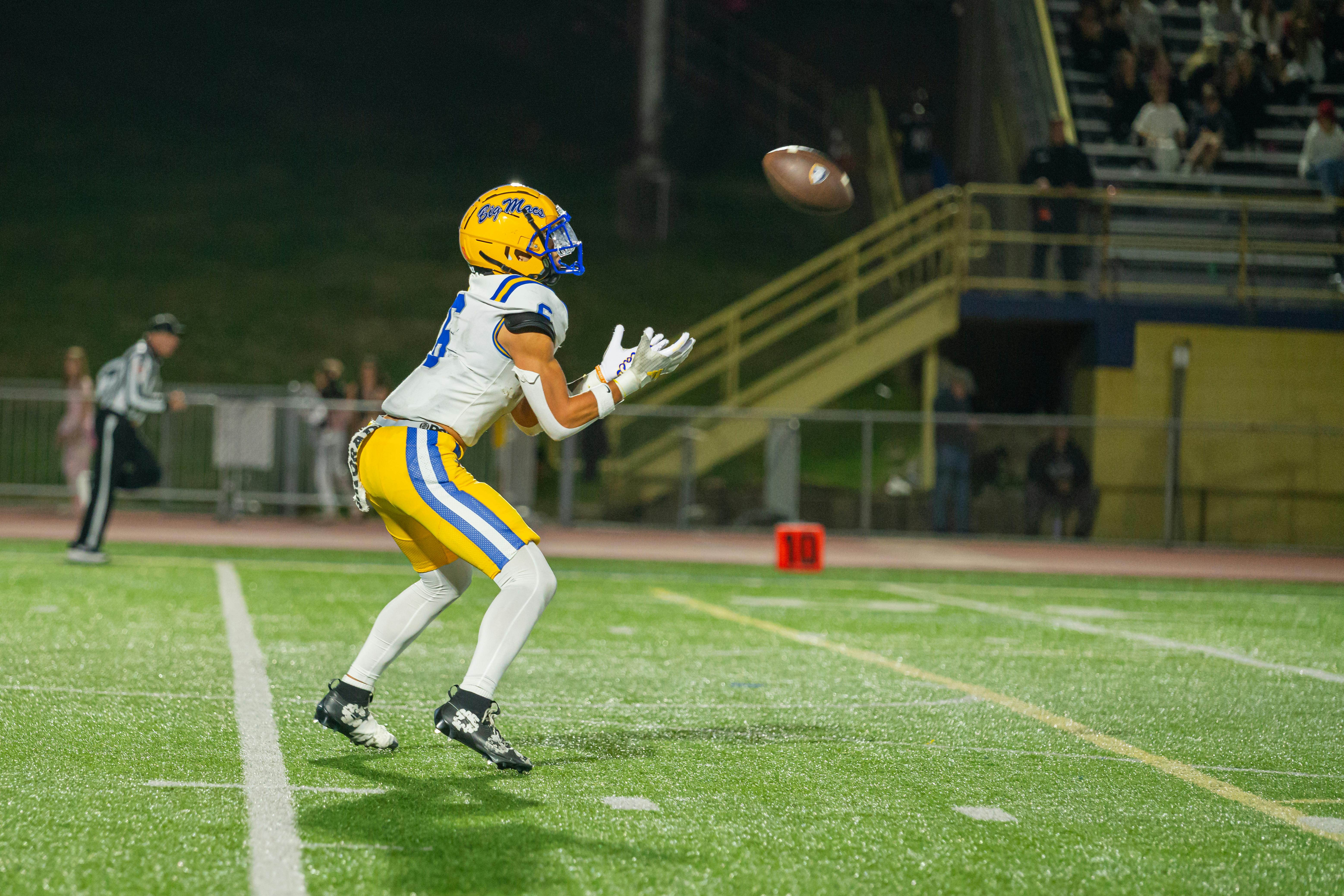Challenge Your NFL Football Last 1000-Yard Receiver Memory
Estimated Reading Time: 15 minutes
This article was created with the assistance of AI, reviewed and curated by Free Betting Tips.
TL;DR
Mastering NFL knowledge, particularly tracking 1000-yard receivers, offers a significant edge in sports betting. These elite performers are crucial offensive anchors, influencing game outcomes and prop bets. Understanding their historical performance and current team dynamics provides valuable insights for predicting future success. Focus on teams with stable quarterback situations and proven coaching schemes to identify potential breakout candidates or consistent producers. Always cross-reference individual player stats with team offensive efficiency and defensive matchups to make informed wagers.
Key Takeaways:
- Historical Context is Key: Knowing a team's history of 1000-yard receivers reveals offensive philosophies and talent development trends.
- Player-QB Synergy: The relationship between a receiver and their quarterback is paramount for consistent production; assess QBs' accuracy, arm strength, and target distribution.
- Offensive Scheme Matters: Air-raid offenses or schemes prioritizing passing often produce multiple high-volume receivers.
- Injury Impact & Depth: Analyze injury reports and team depth charts, as absences can open opportunities for other receivers to step up.
- Betting Market Value: Underrated receivers on strong passing teams can offer excellent value in prop bets for receiving yards.
Table of Contents:
- Background & Context: The Enduring Value of the 1000-Yard Receiver
- Key Insights & Strategies for Identifying Elite Pass-Catchers
- Case Studies: When Receivers Define Offenses
- Common Mistakes to Avoid When Evaluating Receiving Talent
- Expert Tips for Leveraging 1000-Yard Receiver Knowledge in Betting
- Future Trends & Geo-Specific Predictions for Receiving Yards
- Conclusion: Your Ultimate NFL Receiving Edge
- FAQs: Deep Dive into NFL 1000-Yard Receivers
Welcome, gridiron gurus and astute bettors! Do you truly think you know NFL football? Take our ultimate quiz and identify the last 1000-yard receiver for every team. Prove your gridiron expertise! It’s a challenge that separates the casual fan from the serious strategist, and more importantly, it offers a golden opportunity to sharpen your betting acumen. In the fast-paced world of NFL betting, knowledge is power, and understanding the historical performance of key players can unlock significant advantages. The 1000-yard receiver is a benchmark of offensive consistency and a bellwether for team success, making them a focal point for informed wagers. Let's dive deep into what makes these players so crucial and how you can leverage this knowledge.
Background & Context: The Enduring Value of the 1000-Yard Receiver

The 1000-yard receiving season is a hallowed mark in the NFL, signifying a receiver's consistent ability to gain significant yardage and contribute heavily to their team's passing game. It speaks volumes about a player's talent, durability, and their integral role within an offensive scheme. Historically, teams with multiple 1000-yard receivers often boast potent offenses, capable of stretching the field and scoring points at will. For instance, in the 2023 NFL season, a significant number of playoff teams featured at least one 1000-yard receiver, underscoring their importance to offensive success and overall team performance. This demonstrates a strong correlation between elite receiving production and competitive outcomes, a vital insight for any bettor (Source: Pro-Football-Reference.com).
Beyond individual accolades, a receiver consistently hitting the 1000-yard mark often indicates a stable quarterback situation and an effective offensive coordinator. The chemistry between a quarterback and his primary target is undeniable, often developing over multiple seasons. This synergy translates directly into reliable production, which is a goldmine for prop bets on individual player yardage or touchdowns. Conversely, teams struggling to produce a 1000-yard receiver might have issues with quarterback play, offensive scheme, or a lack of elite talent at the position. Understanding these dynamics is the first step in making educated betting decisions.
Key Insights & Strategies for Identifying Elite Pass-Catchers

Analyzing Target Share & Efficiency
One of the most crucial metrics for identifying a potential 1000-yard receiver is their target share. A high target share indicates that the player is a primary option in the passing game, signaling trust from the quarterback and offensive coordinator. However, target share alone isn't enough; efficiency is equally vital. A receiver with a high catch rate and yards per target will turn those opportunities into meaningful production. Look for players who consistently command a significant percentage of their team's targets while maintaining an efficient conversion rate. This combination often leads to consistent high-yardage games, which are invaluable for betting purposes.
Quarterback Play & Offensive Scheme
The success of a wide receiver is inextricably linked to the quality of their quarterback and the offensive scheme they operate within. A top-tier quarterback can elevate the play of his receivers, while a pass-heavy offensive scheme naturally creates more opportunities for receiving yards. Consider teams that rank high in passing attempts per game or have a history of producing multiple 1000-yard receivers. These environments are fertile ground for pass-catching excellence. Conversely, run-heavy teams or those with inconsistent quarterback play may suppress a receiver's potential, even if they possess elite talent.
Opponent Matchups & Defensive Weaknesses
Smart bettors don't just look at a receiver's individual talent; they also factor in their weekly matchups. Certain defenses struggle against particular types of receivers or have weaknesses in their secondary that can be exploited. For example, a team with an elite slot receiver facing a defense notorious for struggling against interior pass-catchers presents an excellent betting opportunity. Researching defensive backfield rankings, cornerback matchups, and opponent pass-defense DVOA (Defense-adjusted Value Over Average) can provide a significant edge (Source: Football Outsiders). This strategic analysis helps in predicting individual receiver performances, especially for yardage prop bets.
Here are actionable steps to integrate these insights into your betting strategy:
- Track Target Shares Weekly: Monitor how targets are distributed within an offense, identifying receivers who are consistently prioritized.
- Evaluate Quarterback Consistency: Assess the QB's recent performance, injury status, and historical chemistry with specific receivers.
- Study Offensive Play-Calling: Understand if a team leans pass-heavy or run-heavy, as this dictates receiving volume.
- Analyze Defensive Matchups: Research opposing secondaries, cornerback grades, and general pass defense efficiency.
- Consider Injury Impacts: Be aware of injuries to other receivers or tight ends, which can increase the target share for remaining healthy players.
- Review Historical Data: Look at a receiver's performance against specific defensive schemes or divisional rivals.
Armed with these strategies, you're well-equipped to identify the next breakout star or the consistent veteran who will anchor your bets. Don't just guess; make informed decisions. For those looking to put their newfound knowledge to the test and Place your bets on Bantubet Kenya, where a world of NFL action awaits.
Case Studies, Examples, or Comparisons
Consider the impact of a generational talent like Justin Jefferson for the Minnesota Vikings. In his 2022 season, Jefferson not only eclipsed the 1000-yard mark but led the league with an astonishing 1,809 receiving yards. His consistent production directly correlated with the Vikings' offensive potency, making them a frequent target for over/under bets and prop bets on Jefferson's individual yardage. This wasn't merely individual brilliance; it was a combination of an offensive scheme designed to maximize his talents and strong quarterback play from Kirk Cousins. Jefferson commanded a significant target share, often exceeding 25-30% of the team's total targets, and maintained an impressive yards-per-reception average (Source: ESPN). This type of dominant individual performance can almost single-handedly alter game scripts and betting lines, highlighting the immense value of a truly elite 1000-yard receiver.
Conversely, a team like the Chicago Bears, despite having talented receivers at times, has historically struggled to consistently produce multiple 1000-yard receivers, often due to fluctuating quarterback play or a run-first offensive philosophy. This comparison illustrates how critical the surrounding environment is for a receiver to reach and maintain the 1000-yard threshold. When evaluating teams for betting, assessing the entire offensive ecosystem—from quarterback to offensive line and coaching philosophy—is paramount. A receiver on a struggling offense, even if talented, may have a much harder path to significant yardage compared to a receiver of similar skill on a high-flying passing attack.
Common Mistakes to Avoid
One of the most common pitfalls for bettors when evaluating receivers is focusing solely on name recognition or previous season's stats without considering context. A receiver who achieved 1000 yards in a previous year might be on a new team, have a different quarterback, or be operating in an entirely new offensive system. These changes can drastically alter their production. Always assess the current situation rather than relying on past glories. For example, a star receiver moving to a team with a struggling quarterback or a more run-heavy scheme might see a significant dip in targets and yardage, despite their inherent talent.
Another mistake is underestimating the impact of injuries, not just to the receiver themselves, but also to their teammates. An injury to a team's star tight end or another wide receiver can temporarily boost targets for the remaining pass-catchers, but it can also lead to increased defensive attention, making it harder for anyone to get open. Similarly, an injury to the offensive line can degrade quarterback play, reducing the time available for receivers to get downfield. Don't forget to look at the strength of schedule; a receiver facing a gauntlet of elite pass defenses in the latter half of the season might struggle to hit their projected totals, regardless of their early-season pace.
Expert Tips or Best Practices
To truly gain an edge, delve into advanced analytics. Metrics such as 'Air Yards' (the distance the ball traveled in the air on a pass attempt) and 'Yards After Catch' (YAC) provide deeper insights into a receiver's role and skill set. A receiver with high Air Yards indicates they are primarily targeted downfield, suggesting big-play potential. High YAC numbers point to a receiver's ability to create after the catch, turning short passes into significant gains. Websites like Pro-Football-Reference and Pro Football Focus offer extensive data that can illuminate these aspects.
Furthermore, monitor coaching changes and free agency moves during the offseason. A new offensive coordinator often brings a new philosophy, potentially favoring certain types of receivers or increasing the overall passing volume. Likewise, key free agent signings or draft picks can signal a shift in a team's offensive priorities. For those serious about their data analysis, consider checking out tools like FantasyPros' Draft Kit on Amazon, which compiles expert rankings and projections that can be invaluable for understanding player value. By staying ahead of these trends, you can identify undervalued assets or anticipate declines before the betting markets fully adjust. These insights are particularly useful when looking at long-term futures bets or season-long player props.
Future Trends or Predictions
The NFL's evolution continues to favor the passing game, suggesting a future with even more prolific receiving performances. Rule changes protecting quarterbacks and limiting defensive contact downfield have opened up opportunities for receivers to thrive. We can anticipate an increase in teams featuring multiple 1000-yard receivers, particularly as offensive schemes become more sophisticated in exploiting matchups. The rise of dual-threat quarterbacks who extend plays also benefits receivers, allowing them more time to get open and create separation.
From a geo-specific betting perspective, markets in regions with high NFL engagement, such as Kenya, will likely see increased interest in player-specific prop bets as data becomes more accessible and predictive models improve. Bettors in Kenya, for example, often show a keen interest in major international sports, and the NFL is growing in popularity. As local betting platforms like Bantubet Kenya expand their offerings, we can expect more diverse and granular betting options for receiving yards, touchdowns, and other player performance metrics. The continued globalization of sports betting will drive more sophisticated analysis and better value opportunities for those who do their homework. The emphasis on individual player performance will only grow, making the knowledge of 1000-yard receivers even more critical for success.
Conclusion: Your Ultimate NFL Receiving Edge
Mastering the art of identifying and understanding 1000-yard receivers is not just a fun trivia challenge; it's a powerful tool in your NFL betting arsenal. From historical context to real-time analytics, every piece of information about these elite pass-catchers contributes to a more informed and potentially profitable wager. By focusing on target share, quarterback synergy, offensive schemes, and defensive matchups, you can cut through the noise and pinpoint where the true value lies. Avoid common pitfalls like outdated information or ignoring critical injury reports, and instead, embrace a data-driven approach that integrates advanced analytics and future trends. Your gridiron expertise isn't just for bragging rights; it's your ticket to smarter betting. So, Place your bets on Bantubet Kenya and leverage your deep understanding of NFL receiving talent to secure your next big win!
FAQs: Deep Dive into NFL 1000-Yard Receivers
Q: How many 1000-yard receivers does an average NFL season produce?
A: The number varies, but typically an NFL season sees anywhere from 25 to 40 players achieve the 1000-yard receiving mark. The 2023 season, for instance, featured a robust class of receivers hitting this milestone, reflecting the league's increasingly pass-heavy nature. You can often find yearly statistics on sites like NFL.com Stats.
Q: Does having a 1000-yard receiver guarantee team success?
A: While a 1000-yard receiver is a strong indicator of offensive potency, it doesn't guarantee overall team success. Football is a team sport, and factors like strong defense, solid special teams, and consistent quarterback play are equally crucial. However, elite receiving talent significantly increases a team's chances of winning, especially in close games.
Q: What are the key factors that contribute to a receiver reaching 1000 yards?
A: Several factors contribute: consistent target volume, efficient catch rate, strong chemistry with the quarterback, a pass-heavy offensive scheme, and the ability to stay healthy for a full season. An offensive line that provides ample time for the quarterback to throw also plays a critical role. For more detailed analysis, consider resources like RotoWire NFL Stats.
Q: How do injuries impact a receiver's chances of hitting 1000 yards?
A: Injuries are a significant impediment. Missing even a few games can make it challenging to accumulate the necessary yardage. Furthermore, playing through injuries can reduce effectiveness and efficiency. Always check injury reports before placing prop bets on receiving yardage totals. Sites like CBS Sports NFL Injury Report are excellent resources.
Q: Are there specific offensive schemes that are more conducive to 1000-yard receivers?
A: Yes, offensive schemes that prioritize passing, often referred to as 'air raid' or 'spread' offenses, tend to produce more 1000-yard receivers. These schemes typically involve higher passing volumes, more designed routes for receivers, and often employ multiple receivers on the field. Teams with innovative offensive coordinators often lead the league in passing yards and, consequently, 1000-yard receivers.
Q: How important is a receiver's age in their ability to reach 1000 yards?
A: Age plays a role, with most receivers hitting their prime between ages 23-29. Younger players often show rapid development, while older players might experience a decline in speed or durability. However, some veteran receivers defy age, extending their careers with exceptional route running and football IQ. Evaluating a player's physical condition and role within the offense is more important than age alone. You can track age-related performance trends on sites like FantasyPros Depth Charts, which often highlight younger players ascending roles.
External Authoritative Links:
- Pro-Football-Reference.com
- Football Outsiders
- ESPN NFL
- Pro Football Focus
- NFL.com Stats
- RotoWire NFL
Internal Link Suggestions (for Free Betting Tips website):















Post a Comment
0 Comments